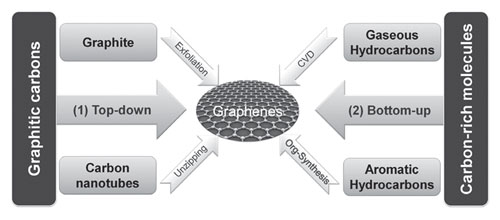The Role of Graphene in Energy Applications
Graphene has potential applications in the energy sector, including energy storage, solar panels, fuel cells, batteries, and thermal management due to its high conductivity, transparency, surface area, chemical stability, and thermal conductivity.
Graphene-based nanomaterials have many promising applications in energy-related areas. Just some recent examples: Graphene improves both energy capacity and charge rate in rechargeable batteries; activated graphene makes superior supercapacitors for energy storage; graphene electrodes may lead to a promising approach for making solar cells that are inexpensive, lightweight and flexible; and multifunctional graphene mats are promising substrates for catalytic systems.
These examples highlight the four major energy-related areas where graphene will have an impact: solar cells, supercapacitors, lithium-ion batteries, and catalysis for fuel cells. An excellent review paper ("Chemical Approaches toward Graphene-Based Nanomaterials and their Applications in Energy-Related Areas") gives a brief overview of the recent research concerning chemical and thermal approaches toward the production of well-defined graphene-based nanomaterials and their applications in energy-related areas.
The authors note, however, that before graphene-based nanomaterials and devices find widespread commercial use, two important problems have to be solved: one is the preparation of graphene-based nanomaterials with well-defined structures, and the other is the controllable fabrication of these materials into functional devices.

Schematic models of chemical strategies towards graphene from different carbon sources. (Reprinted with permission from Wiley-VCH Verlag)
Solar cells
Graphene has great potential to be used for low-cost, flexible, and highly efficient photovoltaic devices due to its excellent electron-transport properties and extremely high carrier mobility. "Recently, several graphene-based solar cells have been reported, in which graphene serves as different parts of the cell. One of the reasons for the current interest in graphene is the great potential for transparent and conductive electrodes in solar cells. Graphene is an ideal 2D material which can be assembled into film electrodes with good transparency, high conductivity, and low roughness."
Graphene also has other attractive properties for photovoltaic devices: "For example, graphene has been incorporated into conjugated polymers to improve the exciton dissociation and the charge-transport properties of the materials. Additionally, graphene also has potential to be used as photoactive material, since its bandgap and band-position can be induced and tuned via chemical functionalization or by controlling the size of the graphene sheets."
Lithium-ion batteries
The energy densities and performances of rechargeable lithium ion batteries – which are used widely in portable electronics such as cell phones, laptop computers, digital cameras, etc. – largely depend on the physical and chemical properties of the electrode materials. Thus, many research attempts have been made to design novel nanostructures and to explore new electrode materials in order to achieve higher capacity and to increase the battery's charge rate, increasingly also employing graphene in form of nanosheets, paper, and carbon nanotube or fullerene hybrids (for a detailed review see here: "Graphene-based electrode materials for rechargeable lithium batteries").
Supercapacitors
Due to its superb characteristics of chemical stability, high electrical conductivity, and large surface area, graphene has been proposed as a competitive material for supercapacitor applications.
"In contrast to the conventional high-surface-area materials, the effective surface area of graphene materials as capacitor electrodes does not depend on the distribution of pores in a solid state, which is different from the current supercapacitors fabricated with activated carbons and carbon nanotubes. Obviously, the effective surface area of graphene materials should depend highly on the layers. Single- or few-layered graphene, with less agglomeration, should be expected to exhibit a higher effective surface area and thus better supercapacitor performance."
Catalysis
Graphene has recently received special interest in the field of catalysis because of its unique two-dimensional structure with its high surface area, special electronic and ballistic transport properties.
"Various graphene-based nanomaterials, such as functionalized graphenes, doped graphene, and graphene/metal or metal oxide composites, are emerging and have been investigated as catalysts for electrocatalytic reactions in fuel cells or other traditional catalytic reactions,"
Outlook
Many critical problems are still waiting for efficient solutions, particularly regarding the precise structural engineering of graphene, which is crucial for both bandgap adjustment and building-block functionalization. Apparently, graphene chemistry is one of the best choices to solve these problems.
Graphene is also emerging as highly attractive materials for mass market applications such as graphene batteries or graphene supercapacitors. However, the production processes and the cost issues still prevent mass market production.
"Since the incorporation of graphene with an active second phase, such as carbon nanotubes, conducting polymers and metal oxides, can dramatically enhance the performance due to the synergistic effects, graphene-based composites are of scientific and industrial interest and may become competitive materials for energy-related applications."
Finding the ideal technique to achieve the desired graphene patterning remains a major challenge. It appears that 3D-printing techniques are an attractive fabrication route towards three-dimensional graphene structures. 3D -printing with graphene results in objects which unlock the ability to theoretically create any size or shape of graphene. Read more in our article on 3D graphene.
Notwithstanding all the progress that has been made in the recent past, the research toward an understanding of the relationship between graphene-based nanomaterials and improved performance in energy-related applications is still at its early stage, and dilemmas remain for further studies.
